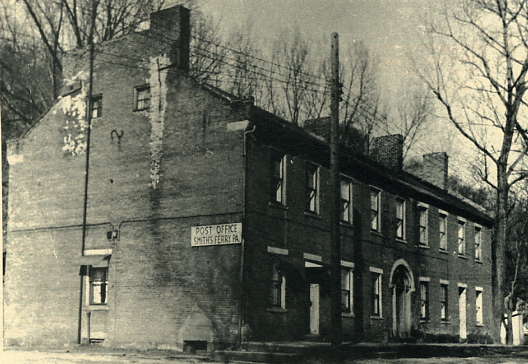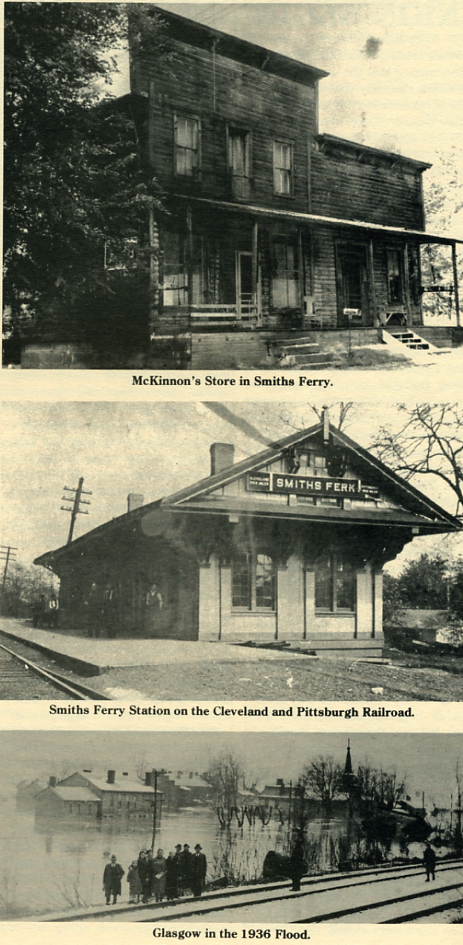
The Old Brick Hotel and Store in Smiths Ferry.
Click Here to Return to Milestones

The Village of Smiths Ferry, in 1790 derived its name from Jesse Smith, founder, who arrived from Maryland with his father, Thomas Smith, settling in Georgetown, across the river from Smiths Ferry. In about 1817, Jesse began operating a ferry boat across the Ohio River, having purchased it from Benjamin Dawson, who operated it for a short period of time before Smith.
The first building erected in Smiths Ferry, by the Smith family, was a two-story red brick hotel in 1835, which was named Smith Hotel. The second two-story wood building called the Western Hotel, was built directly across from it with large livery stables at the side. Jesse Smith owned and managed both. People called the Smith Hotel an " Inn " and Jesse, an "Innkeeper" and "Merchant". The hotels served as stopovers for folks arriving generally from Pittsburgh and the Northwestern territories, by stagecoach, horse and wagon, and by river packets, boarding the horses at the stables. When morning dawned, they would be on their way via river packets and stagecoach for other destinations.
The hotels had small rooms with numbers on the doors and inside were galvanized washstands with galvanized tops. The task of Amos Hamilton, who lived there then, was to empty the water barrels situated in the basement which served as the disposal system for the washstands.
Smiths Ferry at that time was the location of the United States Post Office, servicing the adjoining Ohio Township (now Ohioville) and Glasgow Borough. It was established in about 1835 and operated from the Smith Hotel where it occupied one end section.
Mrs. Blackmore became the Postmaster. In 1935, the hotel observed its 100th birthday anniversary. And in 1958, it was razed by Crucible Steel Company of America, Midland Works. A resident of the hotel, Amos Hamilton, had An old hotel register book recorded with the following transcript: "President James A Garfield's dead body passed this place this am. at 7:40 o'clock for Cleveland, where it was laid away to rest. Age 49 years, 10 months."
The ferry was known to have changed ownership quite frequently, having at one time been owned by William Semple, also a hotel resident, who used the name William Semple Ferry Company.
In 1967, Crucible purchased the holdings of the Montour Railroad Company which included much of the area formerly occupied by the then thriving Village of Smiths Ferry in Ohio Township. Unverified rumors had it that portions of the area were to have been filled with slag and eventually to have had loading docks built for a river-rail terminal. This never occurred.
The Smiths Ferry Post Office, that year, was then moved from the old hotel into the adjacent Borough of Glasgow. The Blackmores and about six hotel residents and about four other families of the area were notified by Crucible to vacate. It was then that the Blackmores purchased from the Montour R.R. Co., the former Amos Hamilton home on Route 68 in Glasgow and moved there along with the postal facility. It was also then that the post office became officially known as "Smiths Ferry Post Office." Earlier postal service in Smiths Ferry began in about 1834.
The old brick hotel, at the time of the razing, was over 120 years old and Smiths Ferry Village, at the mouth of Beaver Creek and the terminus of the Sandy and Beaver Canal, was the major shipping point in the area. There were two large general stores, one owned by John Hooker and the other by Sam and Boge Fair. A school house was located up the hollow at Rockport and one at Glasgow.
Smiths Ferry was a real boom town in the 1860's and 1870's during the oil excitement which followed the drilling of the first commercial well up north near Titusville in 1859 called the Drake Well, and one drilled in the vicinity of the school house. A continuously flowing one beside the Drake Well two years later produced until about 10 years ago, 1958.
Within a few years, hundreds of wells sprung up along Dry Run, Island Run and Little Beaver Creek, as well as in Smiths Ferry, Glasgow and Industry. At one time, no less than 13 oil refineries were in operation in the area and oil from outlying wells was hauled to Smiths Ferry by horse and wagon and sent on to market by river boats and rail.
Glasgow, originally a part of Smiths Ferry, was incorporated in 1854, according to Beaver County Court House records, and became a borough.
Ohio Township originated in 1805 and 1806 out of South Beaver Twp., and consisted of original small villages of Fairview, Ohioville and Glasgow, and the population of all four villages in 1880 was 1,376. In January, 1962, Ohio Township became a borough and was named Ohioville Borough.
In the early days, the Ohio River was cutting away the bank of Smiths Ferry and residents asked to sign a borough charter to undertake the stabilization of the bank against "slip" or erosion. The petition stated that the river was cutting away the bank and narrowing the width of one of the village's principal streets along the river called Front Street.
A stagecoach line, traveling with mail and passengers, ran from Pittsburgh through Georgetown, crossing the Ohio River by ferry at Smiths Ferry, on through the country into Calcutta and Lisbon, Ohio, to a destination in Cleveland, Ohio. The stagecoach was one of the means of transportation of the early settlers.
The ferry boat provided transportation for passengers and delivered the mail to Smiths Ferry Post Office. The mail messenger would begin his rounds in the morning from Hookstown and Georgetown, gather the out-going mail at Smiths Ferry Post Office and load it on the train at the Pennsylvania Railroad station located some 75 yards from the Hotel Post Office.
It was recalled that Charles Skeens of Hookstown, US. Mail Messenger, picked up the mail from the train and deposited it at the Smiths Ferry Post Office and with the mail sacks recrossed the river by ferry into Georgetown and Hookstown. He repeated the procedure in the evening, and supposedly earned $900 a year.
The Smiths were the original postmasters with Samuel Smith's appointment in 1834 and Jesse's in 1866.
Old postal card photos picture an old two-story brick building built by the Masonic Lodge in Smiths Ferry called the "Glasgow Masonic Lodge." It shows a small wooden porch with two sets of steps at the sides held by a wood plank guard. The building was destroyed by fire some 27 years ago. The temple was relocated in Beaver and the general consensus is that in the near future the Lodge plans to construct a new "Glasgow Masonic Lodge," at Shippingport, across from Industry, on a site designated near the new Shippingport Post Office.
A photo of the original survey monument, erected on the front of the Smith Hotel, still stands there.
Several Indian Rocks, located in Smiths Ferry, were landmarks until dredging operations for Montgomery Dam at Industry and the Stratton Dam at New Cumberland, West Virginia, resulted in deeply burying the rocks presumably, never to be uncovered.
Before the dams were erected, the Ohio River was known to dry up at Smiths Ferry during the dry summer season and people traveled by horse and buggy from as far as Pittsburgh, crossing over the dry river bed to view the historical Indian relics. Pictures of Smiths Ferry's Indian Rocks are now printed in the National Geographic and in Bausman's History of Beaver County.
Other treasured photos, taken in the early days of the Post Office, picture Mrs. Blackmore in front of the Smiths Ferry Hotel Post Office during a "Big Snow" fall in about 1950, handing over the mail pouches and mail sacks to Bucky Wilson, now of East Liverpool, mail messenger, who is married and father of two children. The large mail truck he used was the next mode of mail distribution. The snowfall was about 27 inches high during the Thanksgiving season, and printed by someone at the top of the picture were the words, "The Mail Must Go!" no matter what the weather. At that time the truck picked up the mail at East Liverpool and deposited it at post offices located at Smiths Ferry, Midland, Industry, Vanport, Beaver and Rochester.
Another means of transportation, some 55 years ago, was by River Packets, passenger and cargo boats, hauling sheep, hay, grain, cattle, lumber as well as passengers from distant river docks stopping at Smiths Ferry to unload.
Historical Industry Village at that time also transported its commodities, basically lumber, salt and coal, on these river packets which were loaded from a small railroad situated behind Wolf Run Road, Industry.
Prior to the construction of the locks in the Ohio River, the packet mode of transportation was curtailed during the dry spells.
Early residents described the early days of the Beaver Creek Canal Water Route as being carried on with horses walking along the banks of the canal lugging the canal boats on the way to Cleveland and returning the same way.
An interesting story involved Mrs. Thomas Clearwater of Philadelphia, who intended to travel to Cleveland on one of the canal boats and at Beaver Creek, as far as Ravenna, Ohio, the boat broke down, resulting in Mrs. Clearwater's decision to settle there and that is where Clifford was born to his parents, Mr. and Mrs. Frank Blackmore. Frank worked at the Ravenna Railroad and eventually moved his family into Smiths Ferry.
Because dams had not been built during the early days of the post office, floods were numerous in the area following heavy rains including the "Big Flood of 1936."
Clifford told of flood waters cresting at times at about four feet of the center of the post office windows in about 1884, in 1913 and again in 1942. Watermarks on the building showed evidence of the flood's level. In 1936 the flood rose to eight feet reaching the concrete slabs at the top of the high post office windows. Mail delivery was curtailed temporarily and the mail had to be stored on the second floor, some 34 bags at one time.
Hotel residents occupied the upstairs rooms until the flood waters subsided. The mail was brought in by row boat from across the river by Charles Skeens, George Trimble of Georgetown, and Ed Alexander, also of Georgetown.
Once the Smiths Ferry mail facility is moved from its present historical site, Smiths Ferry Village may then become obsolete and completely lose its identity. We hope not, we hope that some reminder will remain of its national heritage. Any day now, the post office department will relocate the service, assumably into Ohioville, following inspection by authorities for future accommodations.
Smiths Ferry is a subdivided community, with a portion in Glasgow Borough and a portion in Ohioville Borough. The present post office building sets in Glasgow with the garage building in Ohioville. Crucible still owns parcels of the land and Pennsylvania Railroad still owns other tracts.
